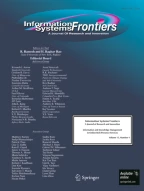Abstract
This paper discusses the development of an enterprise domain model in an environment where part of the domain knowledge is vague and not yet formalised in company-wide business rules. The domain model was developed for a young company starting in the telecommunications sector. The company relied on a number of stand-alone business support systems and sought for a manner to integrate them. There was opted for the development of an enterprise-wide domain model that had to serve as an integration layer to coordinate the stand-alone applications. A specific feature of the company was that it could build up its information infrastructure form scratch, so that many aspects of its business were still in the process of being defined. The paper will highlight parts of the Enterprise Model where there was a need for co-designing business rules together with the domain model. A result of this whole effort was that the company got more insight into important domain knowledge and developed a common understanding across functional areas of the way of doing business.
Similar content being viewed by others
References
Booch G, Rumbaugh J, Jacobson I. The Unified Modeling Language User Guide. Reading, MA: Addison Wesley, 1999.
Coleman D, et al. Object-oriented development: The FUSION method, Prentice Hall, 1994.
Cook S, Daniels J. Designing Object Systems: Object-Oriented Modeling with Syntropy, New York: Prentice Hall, 1994.
D'Souza DF, Wills AC. Objects, Components and Frameworks with UML, The Catalysis Approach. Reading, MA: Addison-Wesley, 1999:785.
Galfione P, Galdiolo A, Valerio A, Cardino G. Exploiting enterprise knowledge through domain analysis and frameworks: An experimental work. Proceedings of the Eleventh InternationalWorkshop on Database and Expert Systems Application, DomE 2000, 4–8 September, Greenwich, London, UK, IEEE Computer Societey, 2000:813–822.
Lindstr¨om C. Lessons learned from applying business modelling: Exploring opportunities and avoiding pitfalls. In: Nilsson AG, Tolis C, Nellborn C, eds., Perspectives on Business Modelling, Understanding and Changing Organisations, Berlin: Springer-Verlag, 1999.
Nellborn C. Business and systems development: Opportunities for an integrated way of working. In: Nilsson AG, Tolis C, Nellborn C, eds., Perspectives on Business Modelling, Understanding and Changing Organisations, Berlin: Springer-Verlag, 1999.
Nilsson AG. The business developer's toolbox: Chains and alliances between established methods. In: Nilsson AG, Tolis C, Nellborn C, eds., Perspectives on Business Modelling, Understanding and Changing Organisations, Berlin: Springer-Verlag, 1999.
Snoeck M, Dedene G. Existence Dependency: The key to semantic integrity between structural and behavioral aspects of object types. IEEE Transactions on Software Engineering 1998;24:233–251.
Snoeck M, Dedene G, Verhelst M, Depuydt AM. Object-Oriented Enterprise Modeling with MERODE. Leuven University Press, 1999.
Snoeck M, Poelmans S, Dedene G. A layered software specifi-cation architecture. In: Laendler AHF, Liddle SW, Storey VC, eds., Conceptual Modeling-ER2000, 19th International Conference on Conceptual Modeling, Salt Lake City, UTAH, USA, Lecture Notes In Computer Science, Vol. 1920, Berlin: Springer-Verlag, 2000:454–469.
Author information
Authors and Affiliations
Corresponding author
Rights and permissions
About this article
Cite this article
Snoeck, M., Michiels, C. Domain Modelling and the Co-Design of Business Rules in the Telecommunication Business Area. Information Systems Frontiers 4, 331–342 (2002). https://doi.org/10.1023/A:1019914823229
Issue Date:
DOI: https://doi.org/10.1023/A:1019914823229
